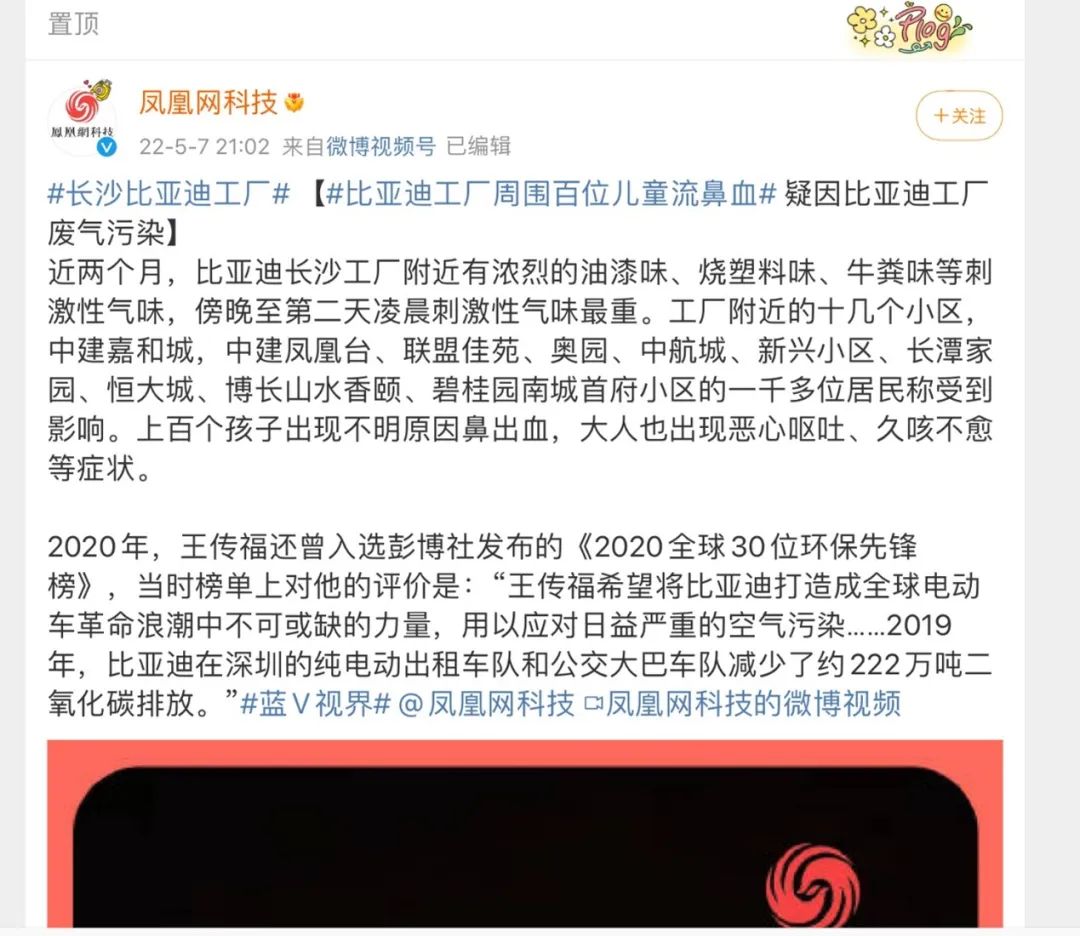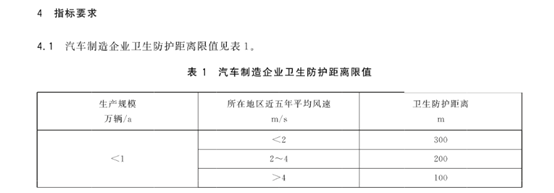
Ⅰ、Case history
On May 7, the entry of "BYD factory in Changsha" was on the hot search of major social media. Residents of more than a dozen nearby communities said that due to the impact of excessive exhaust emissions, hundreds of children had nosebleed of unknown causes in the past two months. Among them, the youngest child was only more than one year old, and adults also had symptoms of nausea, vomiting, prolonged cough and so on. The factory is located at East environmental protection road, Yuhua District, Changsha City, Hunan Province. From the perspective of urban planning, a large number of residential buildings are 100 to 300 meters away from the factory, and some residential areas are only 50 meters away. Late that night, BYD issued a statement saying that "the park's emissions comply with relevant national regulations and standards", "some residential areas close to the industrial park may have peculiar smell" and "the Internet transmission is a malicious fabrication". After several rounds of negotiation, Changsha BYD has installed 24-hour monitoring equipment in many residential areas near Yuhua factory to monitor the air quality nearby in real time. Up to now, BYD has not released the announcement on the shutdown of Changsha base. It has been cross verified from multiple sources that although some production lines have been shut down for rectification, other production lines are still in normal operation, indicating that it has not fully shut down.

(picture from the network)
Ⅱ、Legal interpretation
Article 1229 of the civil code of the people's Republic of China stipulates that "where damage is caused to others due to environmental pollution or ecological damage, the infringer shall bear tort liability." Article 1230 stipulates that "in the event of a dispute arising from environmental pollution or ecological damage, the actor shall bear the burden of proof in respect of the circumstances under which he shall not bear or mitigate his responsibility as provided by law and the absence of a causal relationship between his act and the damage." Article 1232 stipulates: "if the infringer intentionally pollutes the environment and destroys the ecology in violation of the law, resulting in serious consequences, the infringed shall have the right to claim corresponding punitive damages." Article 9 of the law of the people's Republic of China on the prevention and control of air pollution stipulates that "the competent department of ecological environment under the State Council or the people's governments of provinces, autonomous regions and municipalities directly under the central government shall formulate standards for the discharge of air pollutants on the basis of the quality standards for the atmospheric environment and the national economic and technical conditions."
According to the above legal provisions, environmental pollution is a special tort, and the principle of no fault liability is applicable. If the polluter cannot prove that there is no causal relationship between his behavior and the damage consequences, it is presumed that there is a causal relationship. At the same time, if the polluter intentionally violates the law and damages the public interest, he will face punitive damages. In addition, the discharge standard is not completely considered from the capacity of the environment itself, but also takes into account the existing technical capacity, bearing capacity and national economic situation of the enterprise. Therefore, whether the "Park emission conforms to relevant national regulations and standards" in BYD's statement - emission according to standards can be a cause for exemption remains to be discussed.
Specific to this incident, no fault liability is also known as "inversion of the burden of proof" in theory. As far as the liability for damage caused by environmental pollution is concerned, whether the pollution discharge reaches the standard or not is not the constitutive element of liability. Unless BYD can prove that it has legal exemption, that is, there is no causal relationship between its pollution discharge behavior and the damage consequences of environmental pollution in the surrounding sensitive areas, even if it meets the standard and discharges according to the standard, it cannot be exempted from the tort liability under this behavior. Of course, this does not mean that the standard emission is meaningless. Discharge according to the standard is not an act that damages the public interest. Therefore, if BYD's discharge complies with relevant national regulations and standards, it will not be liable for punitive compensation or face environmental public interest litigation.
In addition, it is worth mentioning that the distance between the factory involved and a large number of nearby residential buildings is no more than 300 meters. Whether this act is legally justified also greatly affects its environmental responsibility, and even the legitimacy of the administrative act of the urban planning department. According to people.com, Changsha BYD factory was established in 2009, and many nearby communities were built later than the factory. For example, CSCEC Jiahe urban construction was built around 2018. [i] According to Article 4 of "health protection zone for transportation equipment manufacturing industry Part 1: automobile manufacturing industry" implemented by the National Health Commission on august1,2012 (now it has been completely replaced by "technical guidelines for derivation of health protection zone for unorganized emission of hazardous substances in the atmosphere" implemented on june21,2021), The minimum distance from the boundary of the Department (production workshop or workplace) producing hazardous factors to the boundary of sensitive areas (including residential areas, schools and hospitals) is specified in detail. The main influencing factors are the annual production scale and the average wind speed in the region in recent five years.
According to sina finance and economics, in the first quarter of this year, Changsha BYD produced 62500 cars, accounting for 21% of BYD's total output in the current period. According to this calculation, the annual output of Changsha BYD factory must be more than 100000 vehicles. Even if the average wind speed in Yuhua District in recent five years is greater than 4m/s, the distance between it and the nearby residential buildings should be more than 300 meters. The current urban planning obviously does not meet the relevant standards. [ii]

To sum up, the "Park emissions comply with relevant national regulations and standards" mentioned by Changsha BYD factory in its statement cannot justify its pollution discharge behavior, nor can it be a reason for it not to assume or mitigate its tort liability. At the same time, for the site selection of surrounding residential buildings, whether the urban planning department carries out environmental assessment, demonstration, publicity and other links in the whole administrative process in accordance with relevant laws and regulations remains to be further studied.
Ⅲ、 Conclusion
"Economy" and "environment" have always been the scales that are difficult for countries and regions to balance perfectly. The purpose of environmental legislation is to protect public health and ecological environment, to adapt to economic and social development and to promote sustainable economic and social development.
[1] https://baijiahao.baidu.com/s?id=1732588248648042969&wfr=spider&for=pc
[2] https://baijiahao.baidu.com/s?id=1732332446465339794&wfr=spider&for=pc
© Beijing JAVY Law Firm Beijing ICP Registration No. 18018264-1